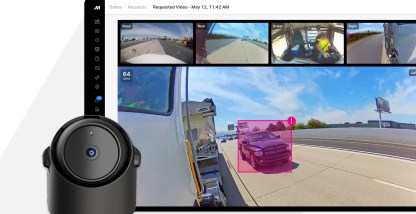In this post about DTC codes, we’ll address the following:
- How DTC codes let the driver know precisely where malfunctions are occurring
- The two types of DTC codes, OBD II and J1939
- How knowing where problems are can save time and money
Diagnostic Trouble Codes (DTCs) are used by a vehicle’s on-board diagnostics system (OBD) to warn drivers when their vehicle encounters a malfunction. The codes were originally created to assist in compliance with federal and state vehicle emission regulations. Over the years, DTCs have evolved to focus on all types of vehicle malfunctions.
When a problem is found, the diagnostic system generates a problem-specific DTC code and then communicates the code to the vehicle’s instrument panel. In trucks equipped with a telematics system, the notification and corresponding code can be sent directly to the fleet manager or, in some cases, directly to the maintenance department.
But in all cases, the most important person in this sequence of events is the vehicle’s driver.
The difference between OBD II and J1939 codes
The rules established by the U.S. Environmental Protection Agency (EPA) require the emission control systems of large highway diesel and gasoline trucks to be monitored for malfunctions via an onboard diagnostic system similar to those systems that have been required on passenger cars since the mid-1990s.
In addition to these requirements, the EPA requires manufacturers to make available to the service and repair industry information necessary to perform repair and maintenance service on OBD systems and other emission-related engine components.
Two different types of DTC codes are in use. OBD II codes were developed for automobiles and light-duty trucks. Commercial, heavy-duty vehicles use J1939 codes. The main difference between the two is in the connection used. The J1939 system uses a 9-pin standard to bridge communications between vehicles and computers, yielding engine diagnostics. Another difference is in the codes themselves. Each version has its own set of codes to relay information about the specific problem.
How do DTC codes work?
As mentioned, OBD II (in light-duty vehicles) and J1939 (in heavy-duty vehicles) trouble codes are standard codes that the vehicle’s onboard detection system utilizes to warn you about a problem. The problem could be already occurring or about to occur. Each code corresponds to a fault detected in the vehicle. When the vehicle’s computer detects an issue that requires attention, it will activate the corresponding code, which is generated using a series of numbers and letters assigned to a specific part of the vehicle.
The warnings are important for saving time and money.
Diagnostic codes indicate that problems such as high engine temperatures and low coolant levels may mean that engine failure is impending. With real-time vehicle diagnostics, technicians and fleet managers can act rapidly. They can evaluate the gravity of the problem, recommend appropriate action, and locate the nearest service center to solve the problem before it becomes a dangerous and expensive situation.
The costs associated with vehicle maintenance and repair rose by 20 percent over the four-year period between 2012 and 2016. This now accounts for about 10 percent of a fleet’s operational expenses. Proactively recognizing trouble issues with a vehicle is vital to keeping your costs in line.
A telematics system with all of the best features may help you detect vehicle maintenance issues as soon as possible with real-time alerts and DTC codes. Installing a telematics system could help you lower operational expenses and repair costs for your fleet while increasing road time and productivity for drivers.
Drivers don’t have to memorize DTC codes
The important thing to remember is that DTCs help you stay on top of your vehicle maintenance. The accuracy of DTCs means the driver doesn’t have to guess what the problem may be. Even more importantly, the trouble codes give you the chance to avoid many problems before they occur by allowing you to track wear and tear, and find out about issues before you see symptoms.
When a code is generated by a vehicle fault, the driver will see the warning immediately. DTC codes are standard alphanumeric codes, and they follow a pattern. For example, a code beginning with the letter P is related to the vehicle’s powertrain. But the driver doesn’t have to know all of the codes (there are thousands of them) off the top of their head. For a fleet that has solid fleet management software and electronic logging devices (ELDs), the system will transmit the definitions for each code.
It’s important to caution drivers never to ignore the warning lights in the vehicle when they come on. Some DTC codes are critical. A continuously lit check-engine light or malfunction indicator lamp (MIL) is a sign of a significant problem with your vehicle that may require immediate attention. The driver should check in with the fleet manager right away and relay the DTC information.
If the vehicle has an on-board diagnostics system, the fleet will have already received the code and definition.
A good telematics system can change things for the better
Businesses that don’t have a trustworthy fleet telematics system in place have to rely on drivers to inform the home office as to what DTC codes are displayed and when. While this is not the most efficient way to handle trouble code issues that arise, it does show the importance of driver awareness of the codes.
If a driver doesn’t let you know immediately that there is a code that needs to be handled, your fleet manager or maintenance department might not become aware of a serious maintenance issue until it’s too late.
A fault code tied into a real-time diagnostics system can deliver information directly to the fleet about potential underlying issues that the driver may not be aware of.
Even though the warnings are transmitted back to your fleet manager or maintenance department (if you have a software program that does that), it is critical for drivers to be aware of any potential or existing problem as well. It’s not simply a matter of saving money. The safety of the driver, the vehicle, and other vehicles are part of the equation as well.
To learn more, see Motive’s complete guide about DTC codes.









